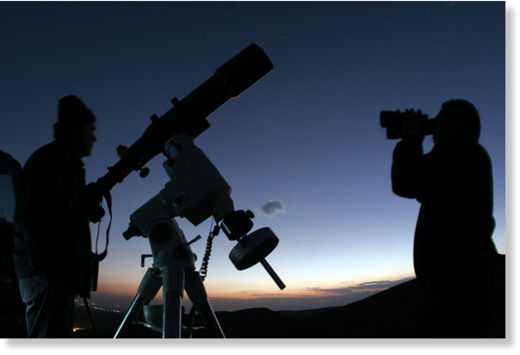
© unknown
Boy, do we have the goodies for you this week. Several multi-object conjunctions, all for your viewing pleasure.
The first are morning events. As you all know, I am not a morning astronomer. However, there are occasions where I make an exception, this is one of them.
First, on Sunday morning, June 26, be outside and find a clear, uncluttered view to the east between 4:45 and 4:30 a.m. MDT.
High to the right is bright Jupiter, the largest of all the planets and just to its left is a very slender crescent moon.
They will be close enough to be in the same binocular field of view.
The next morning, Monday, June 27, an even thinner crescent will move down and left and stand between Jupiter and the tiny star cluster, The Pleiades, or M45, an awesome sight in binoculars.
Moving on to Tuesday, June 28, the moon will be between the Pleiades and the dim planet Mars (look just below the moon).
If you draw a line from Pleiades through the moon, past Mars and on down you will find bright Aldebaran, the eye of Taurus, the Bull.
And the conjunctions just keep on coming, Wednesday, June 29, look for an almost invisible crescent moon between Mars and Venus. Venus will be very low on the horizon.
Tired of all these early morning sessions? Good, so am I, let's shift to the evening.
Tuesday evening, June 28, at about 8:45 p.m. MDT, look northwest for the bright dot that is the planet Mercury, the planet closest to the sun.
To its upper right are two stars, Castor and Pollux, the head stars in Gemini, the Twins. Pollux is the one closest to Mercury.
Watch for the next couple of nights as Mercury moves higher in the sky and further to the left, eventually making a straight line with the two stars on June 30.
Mercury will be visible in the evening sky during the rest of July.
Watch the little planet each night as it moves against the background of stars. That is how the term "planet" came about. Early Greek astronomers noticed there were five stars that did not stay in one place, but moved around the sky.
The word "planet" means "wanderer." Look carefully on Wednesday, July 6, when Mercury tries to hide amid the stars of the Beehive star cluster, M44 located in Cancer, the Crab.
Sky Watch: Third quarter moon tomorrow, June 23. The final launch of a space shuttle is, at present, scheduled for 9:40 a.m. MDT on Friday, July 8. If you would like to watch the launch live, point your favorite web browser to www.nasa.gov/multimedia/nasatv. This will be the last shuttle launch, after this launch the fleet will be retired.
Speaking of retired, NASA announced last week they would no longer attempt to contact the little Mars rover,
Spirit.
The plucky little machine was sent to Mars six years ago with its sister rover, Opportunity, to explore our sister planet.
With a three month mission perimeter she spent more than six years making new discoveries and sending back a wealth of information that will take scientists years to examine.
After
Spirit failed to answer the final revive signal, rover specialists announced the little rover had probably frozen to death at its location near the Gustav crater.
The combination of being stuck in fine, powdery sand and the failure of two of its six drive wheels, they were unable to move it to a place where the dusty solar panels could face the sparse Martian winter sun.
As a result its circuits froze rendering the amazing little machine unable to respond.
Farewell little friend, rest in peace. Its sister, on the opposite side of Mars, continues to function and send back data.
Next Week: More astronomical blathering
Reader Comments
to our Newsletter